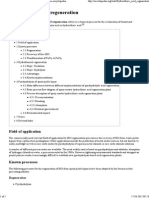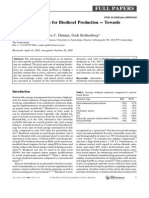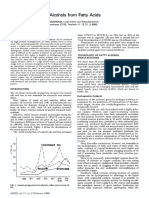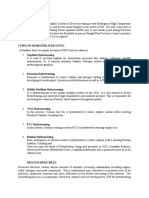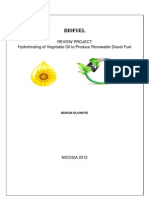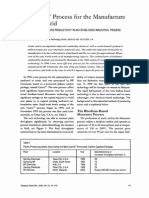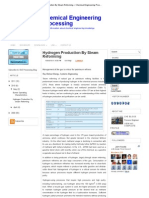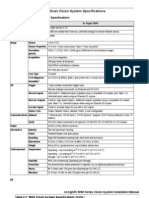United States: (12) Patent Application Publication (10) Pub. No.: US 2009/0163744 A1
United States: (12) Patent Application Publication (10) Pub. No.: US 2009/0163744 A1
Uploaded by
Zaky YanwarCopyright:
Available Formats
United States: (12) Patent Application Publication (10) Pub. No.: US 2009/0163744 A1
United States: (12) Patent Application Publication (10) Pub. No.: US 2009/0163744 A1
Uploaded by
Zaky YanwarOriginal Description:
Original Title
Copyright
Available Formats
Share this document
Did you find this document useful?
Is this content inappropriate?
Copyright:
Available Formats
United States: (12) Patent Application Publication (10) Pub. No.: US 2009/0163744 A1
United States: (12) Patent Application Publication (10) Pub. No.: US 2009/0163744 A1
Uploaded by
Zaky YanwarCopyright:
Available Formats
US 20090163744A1
(19) United States
(12) Patent Application Publication (10) Pub. No.: US 2009/0163744 A1
Abhari et al.
(54)
(43) Pub. Date:
HYDRODEOXYGENATION PROCESS
(76) Inventors:
.
.
Ramln
Abharl,. Blxby,
OK (U S);
Jun. 25, 2009
Publication Classi?cation
( 51)
Int. Cl.
(52)
US. Cl. ....................................... .. 568/876; 585/733
Peter Havlik, Tulsa, OK (US)
C07C 27/02
(200601)
Correspondence Address:
Hall, Estill, Hardwick, Gable, Golden &
(57)
Nelson, RC,
100 North Broadway, Chase Tower, Suite 2900
Oklahoma City, OK 73102 (US)
A process for producing a hydrocarbon from biomass. A feed
stream having free fatty acids, fatty acid esters or combina
tions thereof is provided. The feed stream is heated in the
presence of a ?rst catalyst to produce a partially hydrodeoxy
(21) Appl, No;
11/961,501
ABSTRACT
genated stream. The partially hydrodeoxygenated stream is
heated in the presence of a second catalyst to produce an
(22) Filed;
Dec, 20, 2007
effluent stream containing the hydrocarbon.
Patent Application Publication
Jun. 25, 2009 Sheet 1 0f 3
US 2009/0163744 A1
Patent Application Publication
Jun. 25, 2009 Sheet 2 0f 3
U)
E\
US 2009/0163744 A1
l/\ momw
3.9m:
,N:
\ \w:/M:
(12Q2\ )/1%
AA
\
or
.\
x:
\\
E\\
Wm:
A
Patent Application Publication
Jun. 25, 2009 Sheet 3 0f 3
US 2009/0163744 A1
US 2009/0163744 A1
Jun. 25, 2009
HYDRODEOXYGENATION PROCESS
at high temperature and reduce catalyst activity. HoWever the
level of dilution reported for good results is betWeen 3% and
STATEMENT REGARDING FEDERALLY
SPONSORED RESEARCH OR DEVELOPMENT
20%. This level of feed dilution translates to a signi?cant
increase in reactor siZe and separation/recycle costs.
[0012] Use of pre-hydrogenation to saturate the double
bonds in the triglyceride is described in other prior art. HoW
ever, this pre-hydrogenation describes the Well-known veg
etable oil hydrogenation process Which does not remove any
oxygen. As such, the hydrogenolysis load on the main HDO
[0001] Not applicable.
CROSS-REFERENCE TO RELATED
APPLICATIONS
[0002] Not applicable.
BACKGROUND OF THE INVENTION
[0003]
[0004]
1. Field of the Invention
The present invention relates generally to a process
Which removes oxygen from biomass, and more particularly,
not by Way of limitation, to an improved hydrodeoxygenation
process.
[0005]
2. Brief Description of the Related Art
[0006]
Biomass is a reneWable alternative to fossil raW
catalyst is not affected by such pre-hydrogenation.
[0013] To this end, although processes of the existing art
utiliZe biomass to produce biofuels, further improvements are
desirable to increase HDO ef?ciency, reduce Water partial
pressure in the reactor, achieve a loW capital/loW operating
cost method of removing heat from the ?xed-bed reactor
system, or address the problems With high acid feeds (char
acteristic of fatty acid containing biomass), Which impacts
materials in production of liquid fuels and chemicals.
Increase of biofuels production is part of the governments
strategy to improve energy security and reduce green house
preheater/reactor metallurgy and catalyst attrition. It is to
gas emissions. HoWever, most biomass has high oxygen con
BRIEF DESCRIPTION OF THE DRAWINGS
tent Which loWers fuel quality and heat value. Upgrading
biomass or biomass intermediates into high quality hydrocar
bon fuels thus requires removal of oxygen. The biomass
oxygen may be in the form of an ester, carboxylic acid or
hydroxyl groups.
[0007] Removal of oxygen by catalytic reaction With
hydrogen is referred to as hydrodeoxygenation (HDO). This
reaction may be conducted With conventional ?xed-bed
bimetallic hydrotreating catalysts such as sul?ded nickel
molybdenum (NiMo) or cobalt-molybdenum (CoMo) Which
are commonly used in re?neries.
[0008] Unre?ned vegetable oils and animal fats have sev
eral hundred ppm phosphorus in the form of pho spholipids. In
such a process that the present invention is directed.
[0014]
FIG. 1 is a schematic diagram of an operation of a
hydrodeoxygenation process according to the present inven
tion.
[0015] FIG. 2 is a schematic diagram shoWing an altema
tive embodiment of a hydrodeoxygenation process according
to the present invention.
[0016]
FIG. 3 is a gas chromatogram of Run 1 shoWn in
Table III.
[0017]
FIG. 4 is a gas chromatogram of Run 2 shoWn in
Table III.
addition, animal fats may contain up to a thousand ppm metal
chloride salts. The salts are soluble in the fat/ grease feed, but
come out of solution during the HDO reaction and plug the
SUMMARY OF THE INVENTION
catalyst bed. The metals/ salts can also deactivate the catalyst
by reducing available pore surface. In the presence of free
fatty acids, metal chlorides may form soluble soaps (e.g.
[0018] Vegetable oils, animal fats, and greases are glycer
ides (di- and tri-esters) With varying concentrations of free
calcium stearate). In such form, metals are dif?cult to remove
fatty acids (carboxylic acids).
Several prior art processes for producing fuels from
[0019] The ideal triglyceride HDO conversion is shoWn in
Equation (1). More typically, the HDO reaction is accompa
nied by the DCO reaction shoWn in Equation (2). Since DCO
starting materials such as plants and animals are knoWn.
involves loss of a carbon atom While HDO does not, the ideal
using conventional cleanup technologies such as Water Wash
mg.
[0009]
Conversion of vegetable oils to n-paraf?ns has been reported
HDO reaction is preferred for high hydrocarbon yields. Fur
in the prior art. Some prior art has shoWn that the process may
be applied to other forms of biomass such as tall oil fatty
thermore, DCO generates CO2 and CO Which need to be
removed from the recycle hydrogen, thus adding to the co st of
acids, animal fats, and restaurant greases. HydroisomeriZa
tion of the bio-derived n-paraf?ns to isopara?inic diesel has
been taught in the prior art.
the HDO process.
[0010] Other prior art describes use of feed treatment
upstream of an HDO reactor. Overall cleanup ef?ciency of
75% is reported. HoWever no attempt is made to improve the
hydrocarbon yields by increasing HDO ef?ciency. In fact the
CO+CO2 yields reported are as high as 15% (Which is near
[0020] By conducting the HDO conversion in tWo selective
steps, the ideal Equation (1) conversion for the triglyceride is
accomplished. The tWo selective HDO steps involve: l)
cracking of the triglyceride into a fatty alcohol and a diester
(Equation (3)), and 2) hydrodeoxygenating the fatty alcohol
and the diester to paraf?ns (Equations (5) and (6)). (Equation
theoretical maximum decarboxylation (DCO), suggesting
(3)+Equation (5)+Equation (6):Equation (1)). The ?rst step
very loW HDO e?iciency).
uses a loW activity catalyst such as Mo, the second step
[0011] Still other prior art teaches use of feed dilution to
achieve better catalyst life. Solvent dilution is used to loWer
average bed temperatures for the exothermic HDO reaction,
Which in turn reduces the heavy side products that are formed
requires use of higher activity catalysts such as NiMo. The
process uses tWo different types of catalysts to achieve tWo
selective HDO reactions. The ?rst step HDO reaction also
converts the free fatty acid according to Equation (4).
US 2009/0163744 A1
Jun. 25, 2009
Equations:
periodic table, as fully reduced metal or metal sul?de. Since
the ?rst stage HDO reactor 108 acts as a guard reactor for a
[0021]
second stage HDO reactor, provisions for mitigating fouling
are made by using larger-size, high void catalysts. One
example of a catalyst that may be used in the ?rst stage HDO
reactor 108 is TK-709 commercially available from Haldor
Topsoe. The reaction Which occurs in the ?rst stage HDO
reactor 108 converts the fatty acids to para?in (Equation (4)),
While cracking the triglycerides into fatty alcohols and
smaller esters (Equation (3)).
[0023] The e?iuent 109 of the ?rst stage HDO reactor 108
is cooled through a feed-effluent heat exchanger 11011. A
cooled stream 111 contains hydrocarbons, fatty alcohols, and
esters in liquid phase, and hydrogen and Water vapor in gas
phase. Additional Water is introduced to Wash the salt deposits
that are formed upon condensation of Water. The tWo phase
cooled stream 111 is cooled further in air cooler 11019 to
condense all Water. Water, organic liquid, and hydrogen-rich
vapor are separated in a three-phase separator drum 112.
[0024] With the fatty acids converted in the ?rst stage HDO
reactor 108, the metals not trapped in the catalyst are expected
CH2
H2O
CH2_OCOC17H33
(1,3- and 1,2-diesters)
(4)
>
C18H38
ZHZO
(5)
to be removed With drum 112 Water stream 1130. A hydrogen
rich vapor phase 11311 from drum 112 is recycled to the HDO
reactors. A partially hydrodeoxygenated liquid 11319 is com
bined With recycled hydrogen 135. A combined stream 114 is
heated in the heat exchanger 113a before entering a second
stage HDO reactor 116 at about 550 F. Since the fatty acids
Were converted in reactor 108, the heat exchanger 11a and the
second stage HDO reactor 116 need not be designed for acid
service. The remaining oxygen atoms in the fatty alcohol and
diester intermediate are removed via hydrogenolysis over a
CH2
10H2
>
zclgn38
bimetallic catalyst, such as sul?ded NiMo on alumina in the
second stage HDO reactor 116 (Equations (5) and (6)). Other
CH2OCOC17H33
catalysts suitable for use in reactor 116 include sul?ded
CoMo and NiMo on supports such as alumina, aluminum
(1,3- and 1,2-diesters)
C3H8
4 H20
phosphate, silica, or combinations thereof.
[0025] Ef?uent 117 is cooled in the heat exchanger 105. A
cooled stream 118 contains n-para?ins in liquid phase, and
Water, hydrogen, and propane in vapor phase. Liquid and
Note: Oleic acid is shown as typical fatty acid for all illustra
tive reactions. It should be understood by one of ordinary skill
in the art that the fatty acid composition may vary consider
ably in feed stocks of different origin.
DETAILED DESCRIPTION OF THE INVENTION
[0022] Referring noW to the drawings, and more particu
larly to FIG. 1, shoWn therein is a schematic of the operation
of the process in accordance With the present invention as
vapor are separated in a drum 119. A vapor stream 12011 is
cooled in an air cooler 122 to condense the light hydrocarbons
(including propane) and Water. A three phase stream 123 is
separated in a drum 124 into a hydrogen-rich vapor stream
12511, a paraf?n product stream 125b, and Water 1250. The
Water is combined With HDO Water 1130 from reactor 108
and sent to offsite Water treatment for use or disposal. Paraf?n
product streams 12019 and 1251) may be combined into a
described herein. A biofeed 101, containing fatty acids and/or
fatty acid esters, is pressurized to betWeen about 1,200-1,800
psig using pump 102. A pressurized biofeed 103 is combined
single stream 126. The n-para?ins in stream 126 may be
hydroisomeriZed to isopara?inic diesel and/ or hydrocracked
to isopara?inic kerosene jet fuel. The LPG and naphtha co
products may then be separated. A ?xed-bed reactor similar to
the HDO reactors described herein may be used for hydroi
With a recycled hydrogen stream 134 (compressed to the same
pressure) such that a combined reactor feed 104 is heated
Group VIIIB metals such as platinum, palladium, and nickel
through a feed-effluent heat exchanger 105 before further
heating to the desired reactor inlet temperature of betWeen
about 600-6500 F. in heater 106. A preheated feed stream 107
rided alumina, silica, ferrierite, ZSM-12, ZSM-21, SAPO-11,
enters a ?rst stage HDO reactor 108. The ?rst stage HDO
reactor 108 is packed With a high pore capacity alumina
impregnated With a loW activity hydrogenation metal. In addi
tion to alumina, silica, aluminum phosphate, and combina
tions of these, may also be used. Suitable active metals for this
type of catalyst include molybdenum, chromium, tungsten,
copper, and others from Group VIIB, VIIB, and IB of the
someriZation/hydrocracking. Suitable catalysts include
on amorphous or crystalline supports such as alumina, ?uo
and SAPO-31.
[0026] The desired hydrogen concentration in a recycle
treat gas 133 may be reached by purging (stream 127) some of
the recycle hydrogen and replacing that With makeup hydro
gen (stream 132). To reduce the purge/recycle ratio, hydro
gen-rich vapors 121 may be processed through a puri?cation
unit 129. Impurities such as hydrogen sul?de, ammonia, car
bon dioxide, and carbon monoxide present in recycle treat gas
US 2009/0163744 A1
Jun. 25, 2009
128 are thus removed in unit 129 to provide high purity
hydrogen treat gas 130 for HDO reaction Scrubbers (absorp
tion columns) are commonly used for this application.
Makeup hydrogen gas 132 is pressurized in compressor 131a
and combined With treat gas 130 in recycle compressor 13119
TABLE I-continued
Fatty Acid Distribution of Feedstock (Wt %)
015:1
C16:1
017:1
018:1
018:2
018:3
020:1
020:2+
to provide the treat gas for the HDO reactors.
[0027] Referring to FIG. 2, shoWn therein is another
embodiment of the operation of the process generally in
accordance With the invention as described herein except that
the Water from the ?rst stage HDO reactor 108 is not recov
ered as a liquid e?luent. Instead, Water vapors from both HDO
reactors 108 and 116 are combined as vapor stream 12111 for
<0.1
4.4
0.1
42.4
19.2
1.1
0.8
0.2
condensing in the single air cooler 122. Although a loWer
capital cost embodiment, the Water soluble salts are not
removed With inter-stage Water e?luent. Modi?cations may
be made to the tWo-stage HDO process to account for changes
in feed quality as shoWn in FIG. 2. For example, if the feed is
de?cient in organic sulfur, a sulfur agent must be introduced
to keep the catalysts in the sul?de state. As another example,
hydrogen quench may be employed to reduce the temperature
rise across each bed. Additionally, removal of Water betWeen
the tWo reaction stages provides an effective means of remov
ing reaction heat and decreases Water partial pressure (and
increases the hydrogen partial pressure) Which is knoWn to
increase catalyst stability. It should be understood by one of
ordinary skill in the art that such modi?cations are Within the
TABLE 11
Performance of First Stage HDO Reactor (Note a)
First Stage HDO Reactor Temp
500 F.
600 F.
650 F.
72.3
1.26
37.9
7.35
1.65
79.1
0.87
0.851
26.5
Product Analysis
Acid number(mg KOH/g)
% Unsaponi?ables
% Free fatty acids
38.05
19.95
% Triglycerides (Note b)
5 8.48
5 6.73
5.34
57.2
2.81
16.5
ICP Analysis (Wppm)
spirit of the inventive tWo-stage HDO process.
[0028] The tWo-step HDO process solves other process
needs not met by a single stage adiabatic ?xed-bed reactor
typically used in the prior art. The tWo-step process provides
an effective Way of removing heat from the exothermic HDO
conversion, reduces Water partial pressure, and prevents con
Water
CO
C02
taminants from deactivating/plugging the high activity cata
Feed
Iron
142
42.7
25.1
Phosphorus
193
31.6
91.3
Group I + II metals
987
358
439
75.9
508
Byproduct yields (Wt %)
4
4
4
1.23
0.23
0.0
5.58
0.45
0.15
6.6
0.72
0.70
lyst bed. Furthermore, by selectively converting the free fatty
Notes:
acids in the ?rst stage HDO reactor 108, the corrosive load on
the second stage HDO reactor 116 and catalyst is eliminated.
(a) All runs at 1600 psig pressure, 2 LHSV feed rate, and 7,500 scf/bbl gas
to-oil ratio
(b) GC retention time 22-25 min.
[0029] In order to further illustrate the present invention,
the folloWing examples are given. HoWever, it is to be under
stood that the examples are for illustrative purposes only and
are not to be construed as limiting the scope of the subject
invention.
EXAMPLES
[0031]
A 100 cc pilot plant reactor Was ?lled With a bottom
bed of loW activity molybdenum oxide catalyst and a top bed
of inerts. The bottom bed consisted of 28.2 g TK-709 catalyst
from Haldor Topsoe (ground and sieved to 20+100 mesh
siZe) and 37.8 g of inert glass beads (70+100 mesh). The top
bed Was 19.2 g TK-30 alumina inert reactor topping media
from Haldor Topsoe and 25.2 g glass beads.
Example 1
TWo-Stage HDO Process
[0032] The molybdenum catalyst Was sul?ded by dimethyl
disul?de diluted in ultra-loW sulfur diesel solvent. The maxi
[0030] A blend of broWn grease, yelloW grease, poultry oil,
?oatation grease, and lard Was prepared. The fatty acid pro?le
of the blend is summariZed in Table I. Additional properties,
including free fatty acid and contaminants concentration, are
listed in Table II under the heading Feed.
mum sul?ding temperature was 7000 F. at Which the reactor
Was held for 16 hours. The reactor Was then cooled doWn to
TABLE I
psig H2 pressure While temperature Was ramped to target
400 F. With solvent still ?oWing. Liquid How Was at 2 LHSV
(active catalyst basis) and hydrogen ?oW at 7,000-8,000 scf/
bbl throughout this sul?ding and catalyst break-in period.
[0033]
Fatty Acid Distribution of Feedstock (Wt %)
The feed Was pumped through the reactor at 1600
condition for the experiment. The test conditions and results
are summariZed in Table II.
C12:0
C14:0
C15:0
C16:0
C17:0
C18:0
C20:0
C22:0
C14:1
0.1
0.9
0.1
21
0.3
8.5
0.6
0.1
0.2
[0034] The drop in acid number suggests conversion of free
fatty acids starting beloW 500 F. and virtually complete at
650 F. The gas chromatogram (GC) of the reactor product
stream indicated complete conversion of the triglyceride at
650 F. Further analysis using GC-MS, GC With a para?in
ole?n-alcohol standard, and FTIR spectroscopy con?rmed
that the products of triglyceride conversion Were fatty alco
hols and diesters.
US 2009/0163744 A1
[0035]
Jun. 25, 2009
The product of the 6000 F. and the 650 F. conver
sion runs above Were combined and used as feed to another
100 cc reactor. The reactor contained a NiMo catalyst and Was
sul?ded according to the procedure described earlier in this
What is claimed is:
1. A process for producing a hydrocarbon from biomass,
comprising the steps of:
example. TWo runs at different temperatures and space veloci
providing a feed stream containing biomass having free
fatty acids, fatty acid esters, or combinations thereof;
ties Were conducted and are summariZed in Table 111.
heating the feed stream in the presence of a ?rst catalyst to
produce a partially hydrodeoxygenated stream; and
heating the partially hydrodeoxygenated stream in the
TABLE 111
presence of a second catalyst to produce an effluent
Performance of Second Stage HDO Reactor (Notes a b)
LHSV (hrl)
WABT (F.)
gas-to-oil ratio (scf/bbl)
Run 1
Run 2
3
680
1.5
700
16,000
Speci?c gravity
Water yield (Wt %)
0.805
4.6
10,000
0.795
7.8
Notes:
(a) Reactor feed composite of ?rst stage HDO reactor from 600 and 650 F.
(see Table I)
(b) Both runs at 1600 psig pressure
[0036]
Run 2 resulted in complete conversion to n-paraf
?ns, as suggested by speci?c gravity and GC (FIG. 3). The
HDO ef?ciency Was calculated by ratio of n-C18 to sum of
n-C17 and n-C18. (Since there is very little C17 fatty acid in
the triglyceride/ fatty acid feedstock, all n-C17 must be
formed via DCO.) The HDO ef?ciency Was thus calculated to
be 80%.
Example 2
One-Stage Hdo Process
[0037]
A 100 cc isothermal tubular reactor Was ?lled With
80 cc of NiMo-on-alumina catalyst pellets (commercial cata
lyst from Catalyst Trading Company, Ltd., Houston) and
+70-100 mesh glass beads. The catalyst had the same MoO3/
NiO loading and surface area as the NiMo catalyst of
Example 1 and Was sul?ded according to the method
described therein. The reactor Was operated at 700 F and
1,200-1,600 psig H2 pressure With both vegetable oils and
animal fat feeds. The feed ?oW rate Was 1 LHSV (active
catalyst basis), With about 10,000 scf/bbl H2-to-feed ratio.
The n-para?in products obtained Were analyZed by GC and
the HDO ef?ciency Was calculated according to the method
described in Example 1 . The HDO ef?ciencies Were 630% for
talloW (beef fat), 58% for palm oil, and 66% for canola oil.
[0038] From the above description, it is clear that the
present invention is Well adapted to carry out the objects and
to attain the advantages mentioned herein as Well as those
inherent in the invention. While presently preferred embodi
ments of the invention have been described for purposes of
this disclosure, it Will be understood that numerous changes
may be made Which Will readily suggest themselves to those
skilled in the art and Which are accomplished Within the spirit
of the invention disclosed and claimed.
stream containing the hydrocarbon.
2. The process of claim 1 Wherein the biomass includes
vegetable oils, animal fats, restaurant greases, Waste indus
trial frying oils, tall oil fatty acid, or combinations thereof.
3. The process of claim 1 Wherein the ?rst catalyst is a loW
activity hydrogenation metal.
4. The process of claim 3 Wherein the metal is selected from
the group consisting of molybdenum, copper, iron, chro
mium, and tungsten.
5. The process of claim 1 Wherein the second catalyst is
bimetallic.
6. The process of claim 5 Wherein the bimetal is selected
from the group consisting of NiMo, CoMo, and NiW.
7. The process of claim 1 Wherein the feed stream is heated
to a temperature in a range of about 600 to about 6500 F.
8. The process of claim 1 Wherein the partially hydrode
oxygenated stream is heated to a temperature of about 550 F.
9. The process of claim 1 further comprising the step of:
isomeriZing the hydrocarbon of the effluent stream to pro
vide an isoparaf?n.
10. A process for hydrodeoxygenation, comprising the
steps of:
cracking a triglyceride into at least one fatty alcohol and at
least one diester; and
hydrodeoxygenating the at least one fatty alcohol and the at
least one diester into at least one hydrocarbon.
11. The process of claim 10 Wherein the triglyceride is
cracked in the presence of a loW activity catalyst.
12. The process of claim 10 Wherein free fatty acids are
converted to fatty alcohols and hydrocarbons in the presence
of a loW activity catalyst.
13. The process of claim 11 Wherein the loW activity cata
lyst is selected from the group consisting of molybdenum,
copper, iron, chromium, and tungsten.
14. The process of claim 10 Wherein the at least one fatty
alcohol and the at least one diester are hydrodeoxygenated in
the presence of a high activity catalyst.
15. The process of claim 13 Wherein the high activity
catalyst is selected from the group consisting of NiMo,
CoMo, and NiW.
16. The process of claim 10 further comprising the step of:
isomeriZing the at least one hydrocarbon to at least one
You might also like
- Production of Vinyl Chloride From Ethylene Dichloride by Pyrolysis Aspen Model DocumentationDocument14 pagesProduction of Vinyl Chloride From Ethylene Dichloride by Pyrolysis Aspen Model DocumentationParaiba da Paraiba100% (2)
- Hydrochloric Acid Regeneration - Wikipedia, The Free EncyclopediaDocument5 pagesHydrochloric Acid Regeneration - Wikipedia, The Free EncyclopediazamburittiNo ratings yet
- Hydrogen Gas Production by Partial OxidaDocument69 pagesHydrogen Gas Production by Partial OxidaChinwuba Samuel EbukaNo ratings yet
- Egeberg 2010 - Hydrotreating in The Production ofDocument13 pagesEgeberg 2010 - Hydrotreating in The Production ofNadia RizanedewiNo ratings yet
- Forest Society and ColonialismDocument17 pagesForest Society and ColonialismSatwik Bansal75% (20)
- Hydrogen ProductionDocument31 pagesHydrogen ProductionSajid Ali100% (1)
- United States Patent (10) Patent N0.: US 6,743,952 B2Document8 pagesUnited States Patent (10) Patent N0.: US 6,743,952 B2Rizka AndhikaNo ratings yet
- United States: (12) Patent Application Publication (10) Pub. No.: US 2014/0250770 A1Document10 pagesUnited States: (12) Patent Application Publication (10) Pub. No.: US 2014/0250770 A1Keysler PonceNo ratings yet
- PAtentDocument9 pagesPAtentTri RudiNo ratings yet
- US20140296592A1Document9 pagesUS20140296592A1Ebrahim KazemiNo ratings yet
- Sulfur and Hydrogen Sulfide RecoveryDocument27 pagesSulfur and Hydrogen Sulfide RecoveryChemical.AliNo ratings yet
- Hydrogen Production: P A R T 6Document34 pagesHydrogen Production: P A R T 6Bharavi K SNo ratings yet
- Gabungan Desulfurisasi Ta1Document75 pagesGabungan Desulfurisasi Ta1Rizki MuharomNo ratings yet
- DeC-6 2007Document10 pagesDeC-6 2007Kun ConNo ratings yet
- Catalytic Deoxygenation of Waste Soybean Oil Over Hybrid Catalyst For Production of Bio-Jet Fuel - in Situ Supply of Hydrogen by Aqueous-Phase Reforming (APR) of GlycerolDocument10 pagesCatalytic Deoxygenation of Waste Soybean Oil Over Hybrid Catalyst For Production of Bio-Jet Fuel - in Situ Supply of Hydrogen by Aqueous-Phase Reforming (APR) of GlycerolThiago de Santana SouzaNo ratings yet
- HydrodesulfurizationDocument6 pagesHydrodesulfurizationYuri YamirnovNo ratings yet
- Patent Mekanisme Cao Jadi Caoh2Document9 pagesPatent Mekanisme Cao Jadi Caoh2Ati Devara RachmawatiNo ratings yet
- Harus Selesai Hari IniDocument11 pagesHarus Selesai Hari IniZefanya Maranatha MangunsongNo ratings yet
- Biofuel Production From Palm Oil Deoxygenation Using Ni 2024 Energy ConversiDocument15 pagesBiofuel Production From Palm Oil Deoxygenation Using Ni 2024 Energy ConversiYogesh TimilsinaNo ratings yet
- Y40728 Paper SharjahDocument9 pagesY40728 Paper SharjahCendy Mega PratiwiNo ratings yet
- Solid Acid Catalysts For Biodiesel Production - Towards Sustainable EnergyDocument7 pagesSolid Acid Catalysts For Biodiesel Production - Towards Sustainable EnergyChau MaiNo ratings yet
- Production of Fatty Alcohols From Fatty Acids: ManufacturingDocument3 pagesProduction of Fatty Alcohols From Fatty Acids: ManufacturingPutri Defriska SiagianNo ratings yet
- TK4104 Perancangan Produk KimiaDocument3 pagesTK4104 Perancangan Produk Kimiaaridhiena nurbanieNo ratings yet
- Revamp of Naphtha Hydrotreating Process in An Iranian RefineryDocument6 pagesRevamp of Naphtha Hydrotreating Process in An Iranian RefineryRicardo Alejandro Ruiz NavasNo ratings yet
- Anhydrous Hydrogen Chloride Gas From Hydrochloric Acid and CDocument3 pagesAnhydrous Hydrogen Chloride Gas From Hydrochloric Acid and CbigriverflowsNo ratings yet
- 8 Hydrocracking Vs Catalytic CrackingDocument2 pages8 Hydrocracking Vs Catalytic CrackingAbhinav ShankarNo ratings yet
- Hydrotreating UnitDocument11 pagesHydrotreating UnitAbhishek GogoiNo ratings yet
- HydrogenationDocument189 pagesHydrogenationAlina HafeezNo ratings yet
- Us 5883295Document8 pagesUs 5883295Manuel Gonzalez GalvezNo ratings yet
- EP0878455A1Document9 pagesEP0878455A1محمد عليNo ratings yet
- United States Patent 1191: Tu (45) Sep. 7, 1982Document4 pagesUnited States Patent 1191: Tu (45) Sep. 7, 1982AdyNo ratings yet
- Hydro ProcessingDocument56 pagesHydro ProcessinggeorgiadisgNo ratings yet
- Synthesis of BiodieselDocument11 pagesSynthesis of BiodieselMohamed Abd ElraoofNo ratings yet
- Zoeller. Eastman Chemical Company Acetic Anhydride ProcessDocument19 pagesZoeller. Eastman Chemical Company Acetic Anhydride ProcessJohn Patrick DagleNo ratings yet
- Hydrodesulfurization: HistoryDocument5 pagesHydrodesulfurization: HistoryHevin HassanNo ratings yet
- US4094913Document4 pagesUS4094913Ranjana MadabushiNo ratings yet
- Pavel Šimác Ek, David Kubic Ka, Gustav Šebor, Milan PospíšilDocument5 pagesPavel Šimác Ek, David Kubic Ka, Gustav Šebor, Milan Pospíšilscorpion2001glaNo ratings yet
- United States Patent (10) Patent No.: US 6,458,856 B1: Peng Et Al. (45) Date of Patent: Oct. 1, 2002Document12 pagesUnited States Patent (10) Patent No.: US 6,458,856 B1: Peng Et Al. (45) Date of Patent: Oct. 1, 2002Luigi RussoNo ratings yet
- Desulfurization TechnologiesDocument25 pagesDesulfurization TechnologiesHama SportNo ratings yet
- JatrophasadafartDocument25 pagesJatrophasadafartVijai B RaghavanNo ratings yet
- Patent Application Publication (10) Pub. No.: US 2008/00663.74 A1Document8 pagesPatent Application Publication (10) Pub. No.: US 2008/00663.74 A1AdhityaEkoBagusNo ratings yet
- Mini Project StyereneDocument25 pagesMini Project StyereneMard Apik100% (1)
- Production of Hydrogen From Biomass-Derived LiquidsDocument10 pagesProduction of Hydrogen From Biomass-Derived LiquidsVoinea MarianNo ratings yet
- Section VI.F: Chemical Production ProcessesDocument24 pagesSection VI.F: Chemical Production Processesswadesh1987No ratings yet
- HydrodesulfurizationDocument7 pagesHydrodesulfurizationjcencicNo ratings yet
- An Intensified Reactive Separation Process For Bio-1-10Document10 pagesAn Intensified Reactive Separation Process For Bio-1-10klpiNo ratings yet
- PT01 Us20140081065a1Document14 pagesPT01 Us20140081065a1Ao-Ae SunetraNo ratings yet
- Sulfuric Acid TreatmentDocument9 pagesSulfuric Acid TreatmentShankar AcharNo ratings yet
- HDTB SectorDocument7 pagesHDTB SectorPartha AichNo ratings yet
- Peigao Duan, Xiujun Bai, Yuping Xu, Aiyun Zhang, Feng Wang, Lei Zhang, Juan MiaoDocument9 pagesPeigao Duan, Xiujun Bai, Yuping Xu, Aiyun Zhang, Feng Wang, Lei Zhang, Juan MiaoyemresimsekNo ratings yet
- Biofuel: Hydrotreating of Vegetable Oil To Produce Renewable Diesel Fuel IBUKUN OLUWOYE NICOSIADocument13 pagesBiofuel: Hydrotreating of Vegetable Oil To Produce Renewable Diesel Fuel IBUKUN OLUWOYE NICOSIAIbukun OluwoyeNo ratings yet
- Cativa Process PDFDocument12 pagesCativa Process PDFMonimNo ratings yet
- Production BD From Wate OilDocument8 pagesProduction BD From Wate Oilbala krishnaNo ratings yet
- Hydrogen Production by Steam Reforming Chemical Engineering ProcessingDocument8 pagesHydrogen Production by Steam Reforming Chemical Engineering ProcessingviettiennguyenNo ratings yet
- 48 - 2 - New York - 10-03 - 0784 PDFDocument1 page48 - 2 - New York - 10-03 - 0784 PDFEMYCEE2009No ratings yet
- Alhaji Massoud Juma - Petroleum AssignmentDocument9 pagesAlhaji Massoud Juma - Petroleum AssignmentAlhaj MassoudNo ratings yet
- PT04 Us20110087058a1Document9 pagesPT04 Us20110087058a1Ao-Ae SunetraNo ratings yet
- Advances in Biofeedstocks and Biofuels, Volume 2: Production Technologies for BiofuelsFrom EverandAdvances in Biofeedstocks and Biofuels, Volume 2: Production Technologies for BiofuelsLalit Kumar SinghNo ratings yet
- Synthetic Natural Gas: From Coal, Dry Biomass, and Power-to-Gas ApplicationsFrom EverandSynthetic Natural Gas: From Coal, Dry Biomass, and Power-to-Gas ApplicationsTilman J. SchildhauerNo ratings yet
- Nanoporous Catalysts for Biomass ConversionFrom EverandNanoporous Catalysts for Biomass ConversionFeng-Shou XiaoNo ratings yet
- Og Easy 2012 PDFDocument76 pagesOg Easy 2012 PDFZaky YanwarNo ratings yet
- Us 20120194888Document39 pagesUs 20120194888Zaky YanwarNo ratings yet
- United States: (12) Patent Application Publication (10) Pub. No.: US 2012/0100529 A1Document39 pagesUnited States: (12) Patent Application Publication (10) Pub. No.: US 2012/0100529 A1Zaky YanwarNo ratings yet
- Catalysis Today: Nageswara Rao Peela, Anamika Mubayi, Deepak KunzruDocument7 pagesCatalysis Today: Nageswara Rao Peela, Anamika Mubayi, Deepak KunzruZaky YanwarNo ratings yet
- 02-YT-05 Cable TestingDocument1 page02-YT-05 Cable TestingAry PutraNo ratings yet
- FoundationDocument5 pagesFoundationAnna Rose LoboNo ratings yet
- Inherited Traits and Learned BehaviorsDocument7 pagesInherited Traits and Learned BehaviorsJordanNo ratings yet
- Purpose: Partition CoefficientDocument5 pagesPurpose: Partition CoefficientJamesNo ratings yet
- Kajian Tentang Jurnal B.inggris (Mse, Mape, MadDocument28 pagesKajian Tentang Jurnal B.inggris (Mse, Mape, MadSri adiningsi usmanNo ratings yet
- Crriminalistics June 2019 Set ADocument10 pagesCrriminalistics June 2019 Set AVivian P.avelinoNo ratings yet
- Fish Histology 2 Ndedition NBADocument3 pagesFish Histology 2 Ndedition NBAgoiurilozanoNo ratings yet
- (S1) 6.the Play GroupDocument14 pages(S1) 6.the Play Groupriho.140802100% (1)
- M1A2 Abrams Tank UnlockedDocument6 pagesM1A2 Abrams Tank UnlockedDavid ArangoNo ratings yet
- Environmental Ethics in The Hindu Vedas and PuranasDocument3 pagesEnvironmental Ethics in The Hindu Vedas and PuranasShalini Dhal0% (1)
- Full Airport Finance and Investment in The Global Economy 1st Edition Anne Graham Ebook All ChaptersDocument52 pagesFull Airport Finance and Investment in The Global Economy 1st Edition Anne Graham Ebook All Chaptersllacmabratta100% (3)
- Check Out The Buyers Guide On FacebookDocument32 pagesCheck Out The Buyers Guide On FacebookCoolerAdsNo ratings yet
- Users Manual - Temp-RH Data LoggerDocument26 pagesUsers Manual - Temp-RH Data LoggerJuan Carlos RiveraNo ratings yet
- MEASUREMENT For Grade 7Document47 pagesMEASUREMENT For Grade 7Elaine Galang100% (1)
- Bell's Palsy: Diagnosis and ManagementDocument2 pagesBell's Palsy: Diagnosis and Managementmefav7778520No ratings yet
- Ec9 Ex56 Compression OrthotropicDocument6 pagesEc9 Ex56 Compression OrthotropicimotalpNo ratings yet
- MFL69365753 1Document132 pagesMFL69365753 1Diego Di GiorgioNo ratings yet
- Anodizing of Aluminum by Charles A. Grubbs: CAG Consulting, Lakeland, FLDocument11 pagesAnodizing of Aluminum by Charles A. Grubbs: CAG Consulting, Lakeland, FLpunkassbobNo ratings yet
- Catalogo PMI PDFDocument276 pagesCatalogo PMI PDFArt ManNo ratings yet
- CD-Module 12 Q3Document5 pagesCD-Module 12 Q3kristine kaye malonesNo ratings yet
- Assignment CHP.12Document5 pagesAssignment CHP.12Noor AhmedNo ratings yet
- RT120 ManualDocument161 pagesRT120 ManualPawełNo ratings yet
- Camara IS5604-10Document3 pagesCamara IS5604-10gicatoNo ratings yet
- Berg Balance TestDocument8 pagesBerg Balance TestMiss AANo ratings yet
- Lecture # 06 Controlled RectifiersDocument44 pagesLecture # 06 Controlled RectifiersSohira QaziNo ratings yet
- Case Study Repaired)Document30 pagesCase Study Repaired)eelyenoh18100% (1)
- Lte Fundamentals: Sven-Anders SturessonDocument23 pagesLte Fundamentals: Sven-Anders SturessonHatim SalihNo ratings yet
- Your Cells Are Listening: How Talking To Your Body Helps You HealDocument3 pagesYour Cells Are Listening: How Talking To Your Body Helps You HealGracy JebastinaNo ratings yet
- A Pardes Reading of Johns GospelDocument217 pagesA Pardes Reading of Johns GospelPaolo PagellaNo ratings yet

